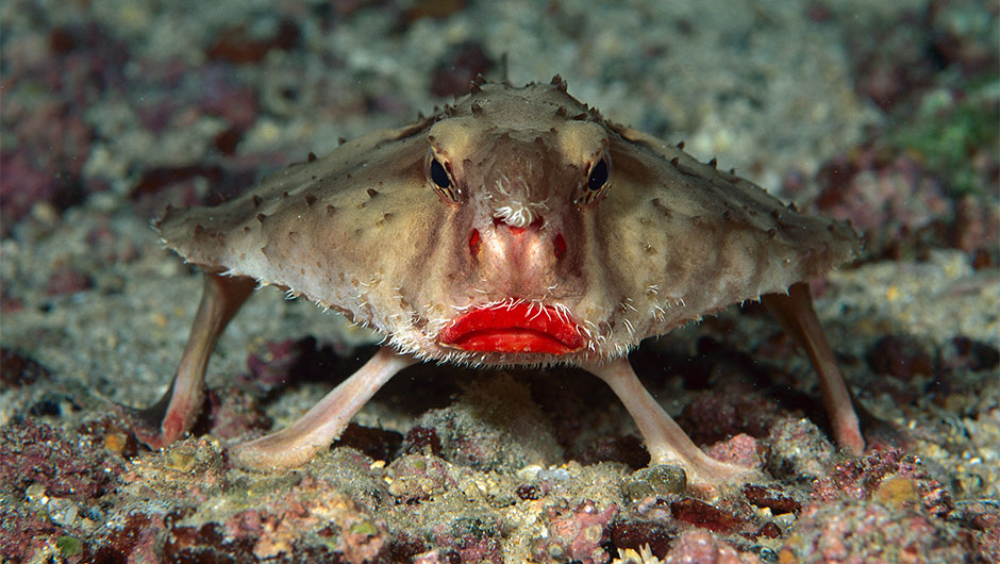The Red-Lipped Batfish (Ogcocephalus darwini), often regarded as one of the ocean’s most peculiar inhabitants, is a species of batfish found primarily around the Galápagos Islands and off the coast of Peru. Known for its striking appearance and unique adaptations, the Red-Lipped Batfish is a subject of fascination for marine biologists and underwater enthusiasts alike.
Physical Characteristics
The Red-Lipped Batfish is instantly recognizable due to its vivid red lips, which stand out against its otherwise muted coloration. This peculiar feature gives the fish a somewhat human-like appearance, reminiscent of someone wearing bright lipstick. The purpose of these striking lips is not entirely understood, though some researchers speculate that they may play a role in species recognition or mating.
In addition to its distinctive lips, the Red-Lipped Batfish possesses a flattened, disk-like body and a broad, triangular head. Its body is covered with rough, scale-like structures called tubercles, giving it a rugged texture. The batfish can grow up to about 40 centimeters (16 inches) in length.
One of the most fascinating aspects of this species is its modified pectoral fins, which have evolved into limb-like structures. These “legs” allow the batfish to walk along the ocean floor rather than swimming. This adaptation is particularly useful in the benthic (bottom-dwelling) habitats where the fish resides.

Habitat and Distribution
The Red-Lipped Batfish is native to the tropical and subtropical waters of the eastern Pacific Ocean. It is most commonly found around the Galápagos Islands and off the coast of Peru, thriving at depths ranging from 3 to 76 meters (10 to 250 feet). The species prefers sandy or rocky bottoms, where it can blend in with its surroundings and hunt for food.
Behavior and Diet
Unlike many fish that rely on swimming to navigate their environment, this animal primarily walks along the seafloor using its adapted pectoral fins. This unique mode of locomotion is complemented by its dorsal fin, which has transformed into a long, slender spine known as an illicium. The illicium functions as a fishing lure, attracting prey towards the batfish’s mouth.
The diet of the Red-Lipped Batfish consists mainly of small invertebrates and fish. It uses its illicium to entice unsuspecting prey, which it then captures with a sudden snap of its mouth. The batfish’s feeding strategy is akin to that of anglerfish. They are known for their similar use of a bioluminescent lure to attract prey.
Reproduction and Lifespan
Little is known about the reproductive behavior and lifespan of this animal. Like many deep-sea creatures, studying their life cycle poses significant challenges due to their often inaccessible habitats. It is believed that, like other batfish species, the Red-Lipped Batfish lays eggs that hatch into larvae, which then undergo several developmental stages before reaching adulthood.
Ecological Role and Conservation
The Red-Lipped Batfish plays a crucial role in the benthic ecosystem as both predator and prey. By controlling populations of small invertebrates and fish, it helps maintain a balanced ecosystem. Additionally, the batfish serves as prey for larger predators, thus contributing to the food web.
Currently, the Red-Lipped Batfish is not considered endangered. However, its habitat is vulnerable to the impacts of human activities such as pollution, climate change, and overfishing. Conservation efforts in marine protected areas, particularly around the Galápagos Islands, are essential for ensuring the continued survival of this unique species.
Scientific Significance
The Red-Lipped Batfish is of great interest to scientists due to its unusual adaptations and evolutionary significance. Studying this species can provide insights into the mechanisms of evolution. Particularly, how certain traits develop to suit specific environmental niches. Additionally, understanding the batfish’s behavior and ecology can contribute to broader knowledge about benthic marine ecosystems and their conservation.
Conclusion
The Red-Lipped Batfish is a remarkable example of nature’s ingenuity, showcasing an array of unique adaptations that allow it to thrive in its specific habitat. Its striking appearance, peculiar walking method, and fascinating feeding strategy make it a subject of endless intrigue. As we continue to explore and understand the complexities of marine life, the Red-Lipped Batfish stands as a testament to the diversity and wonder of the ocean’s inhabitants.









